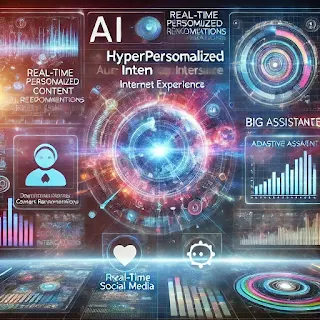Introduction
The internet is evolving at an unprecedented pace, moving towards an era where hyperpersonalization defines our digital experiences. From customized content recommendations to AI-driven virtual assistants, the internet is becoming increasingly tailored to individual preferences, behaviors, and needs. This hyperpersonalization is transforming industries, reshaping online interactions, and redefining how we engage with the digital world.
In this article, we explore the concept of a hyperpersonalized internet, how it works, its benefits and challenges, and what the future holds for a more tailored online experience.
What is the Hyperpersonalized Internet?
Hyperpersonalization refers to the use of artificial intelligence (AI), machine learning (ML), big data, and real-time analytics to create highly customized digital experiences for users. Unlike traditional personalization, which relies on basic user data like location or past interactions, hyperpersonalization delves deeper into:
User behavior and browsing history.
Real-time interactions and engagement.
Psychographic profiling (interests, habits, emotions).
AI-driven predictive analytics to anticipate user needs.
From search engines and social media platforms to e-commerce and digital entertainment, hyperpersonalization is reshaping how information is presented to users.
How Hyperpersonalization Works
The hyperpersonalized internet relies on several advanced technologies to refine digital experiences. The key components include:
1. Artificial Intelligence and Machine Learning
AI and ML algorithms analyze vast amounts of user data to predict preferences and deliver relevant content. These technologies continuously learn from user interactions, improving the accuracy of recommendations over time.
2. Big Data Analytics
Companies collect and process massive datasets from user interactions, website visits, app usage, and purchase history. Big data analytics helps businesses understand user behavior patterns and refine their strategies accordingly.
3. Real-Time Data Processing
Real-time tracking of user activities allows platforms to adjust content dynamically. For example, streaming services like Netflix recommend shows based on what a user is watching at that moment, while e-commerce sites suggest products based on browsing behavior.
4. IoT and Wearable Technology
Smart devices, including IoT-enabled home assistants and wearables like smartwatches, contribute to hyperpersonalization by gathering real-time health data, preferences, and daily routines.
Industries Transforming Through Hyperpersonalization
Hyperpersonalization is not limited to a single industry—it is revolutionizing multiple sectors:
1. E-Commerce
Retailers use AI-driven recommendations, personalized promotions, and dynamic pricing to enhance customer experiences. Examples include Amazon’s product recommendations and personalized shopping assistants.
2. Digital Marketing and Advertising
Hyperpersonalization in advertising delivers highly targeted campaigns. Companies use behavioral tracking to display personalized ads, increasing engagement and conversion rates.
3. Streaming Services
Platforms like Netflix, Spotify, and YouTube offer hyperpersonalized content suggestions based on user preferences, watch history, and engagement patterns.
4. Healthcare and Wellness
AI-powered health apps track physical activity, monitor vital signs, and offer personalized fitness and diet plans. Telemedicine services tailor treatments based on a patient’s medical history and lifestyle.
5. Financial Services
Banks and fintech companies use hyperpersonalization for tailored financial advice, fraud detection, and custom investment recommendations.
Benefits of the Hyperpersonalized Internet
The rise of hyperpersonalization brings numerous advantages:
1. Enhanced User Experience
Users receive content, services, and recommendations that align closely with their preferences, reducing information overload and improving satisfaction.
2. Increased Efficiency
Hyperpersonalization saves time by delivering relevant results instantly. Whether searching for products, content, or services, users get what they need faster.
3. Higher Engagement and Retention
Businesses benefit from higher customer engagement, as personalized experiences create stronger brand loyalty and reduce bounce rates.
4. Improved Decision-Making
AI-driven recommendations help users make informed decisions, from choosing entertainment to managing finances and healthcare.
Challenges and Concerns of a Hyperpersonalized Internet
Despite its advantages, hyperpersonalization also presents challenges and ethical concerns:
1. Privacy and Data Security
Collecting and processing vast amounts of user data raises concerns about data privacy and security. Users worry about how their information is used and whether it is shared without consent.
2. Risk of Filter Bubbles and Echo Chambers
Hyperpersonalized content may limit exposure to diverse perspectives, reinforcing existing biases and reducing critical thinking.
3. Over-Reliance on AI
AI algorithms can make mistakes, leading to inaccurate recommendations or manipulative practices that prioritize profit over user well-being.
4. Ethical Implications
Concerns about surveillance, data exploitation, and manipulation highlight the need for transparent AI and ethical data usage policies.
The Future of Hyperpersonalization
The hyperpersonalized internet is expected to continue evolving with emerging technologies:
1. AI-Driven Virtual Assistants
Voice assistants like Alexa, Google Assistant, and Siri will become more intelligent, predicting user needs and automating daily tasks.
2. Personalized AI-Generated Content
AI tools will create hyperpersonalized news articles, entertainment, and interactive experiences tailored to individual users.
3. Blockchain for Data Privacy
Blockchain technology may offer users greater control over personal data, ensuring privacy while still allowing hyperpersonalization.
4. Adaptive Learning in Education
AI-driven educational platforms will offer personalized learning experiences, adapting content based on students’ learning styles and progress.
Conclusion
The hyperpersonalized internet is transforming digital experiences across industries, offering tailored solutions that enhance convenience, efficiency, and engagement. While this shift brings numerous benefits, it also requires careful management to address privacy concerns, ethical challenges, and algorithmic biases.
As AI and big data continue to advance, the future of the internet will be even more customized, creating a digital ecosystem where personalization meets responsibility. The key lies in finding a balance between convenience and ethical considerations to ensure a safe and inclusive online experience for all users.

No comments:
Post a Comment